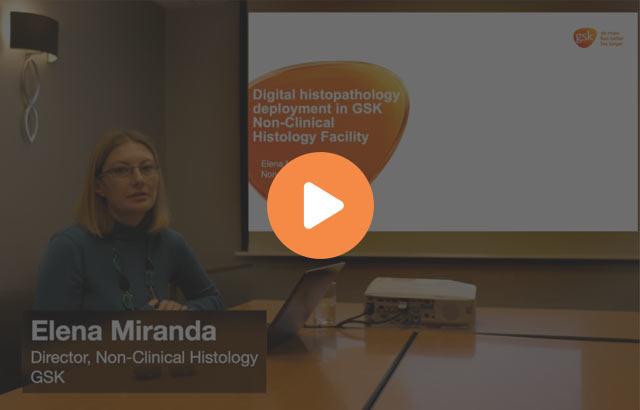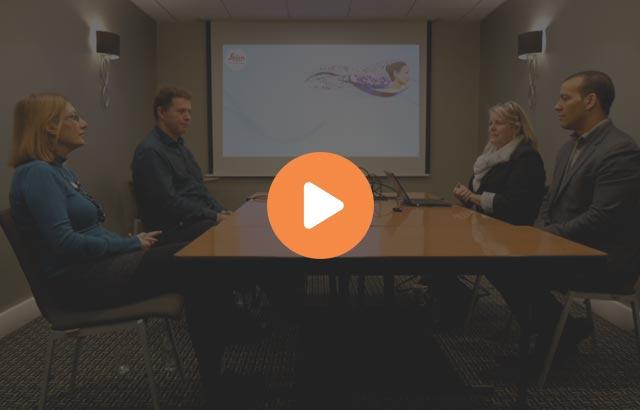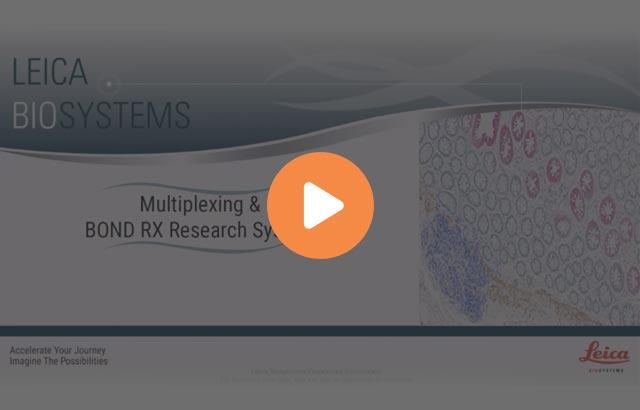Chromogenic Co-detection of Protein and mRNA Targets in Tissues using the BOND RX Fully Automated Research Stainer

Co-detection of more than one target in Formalin-Fixed Paraffin Embedded samples is an extremely useful application and one that is increasingly required in modern histopathology labs.
In order to detect both protein and mRNA targets in the same section, Bradley Spencer-Dene at GSK, has established a fully-automated workflow for sequentially detecting protein and mRNA targets chromogenically on the BOND RX research stainer combining AP/Fast Red detection (RNAscope/Basescope in situ hybridization) with HRP/Green detection (Immunohistochemistry) to establish target mRNA expression in the context of cell lineage detection.
For Research Use Only. Not for use in diagnostic procedures.
Webinar Transcription
One recent set of experiments that I've been working on has been to incorporate a new co-detection assay whereby on formalin-fixed paraffin-embedded tissues we can detect both an mRNA target and then also sequentially an immunohistochemistry protein target as well, chromogenically. It's not multiplexing in the sense of looking at dozens and dozens of targets, but it's allowing us to combine immunohistochemistry and in-situ hybridization together and try and, as I said, maximize the information that you can generate from a limited set of tissues.
This is an assay that's available on the Leica BOND RX or manually, and that's why ideally, we'll always try and incorporate assays that can be run in an automated, high-throughput, reproducible way, preferably overnight as well. That is a much more efficient use of our time and helps with reproducibility. That's another big benefit of this assay. The primary objectives of this work were to set up and establish the assay and to look for different mRNA targets. I'll come on to those towards the end and then protein cell markers.
In this instance, I'm going to demonstrate detection of mRNA chromogenically and then use antibodies to come in and detect various different cell lineages so that you can assign or the pathologist can assign the RNA signal to immune cells or tumor versus stroma, that thing. And as I said, the ideal way would be to run this fully or semi-automated overnight, and then that saves technician time. The workflow is based on RNAscope, so this is an assay from ACD, now Bio-Techne. To take you through the workflow, the tissue section is that purple square on the slide, or you could have cells that are cultured adherent cells or cell pellets. But in any case, it needs to be on a positively charged glass slide. And this is, as I said, is formalin fixed material. And then the first thing we have to do is to break those formalin cross-links and then permeabilize the tissue in some way to enable the next set of reagents to bind and do their stuff.
Hybridization, so this is where we're looking at complementary probes that are specifically going to bind to your RNA target of choice. And these are designed in a special way. These are double Z probes that I'll come on to a little later. And then the way the assay works is that once those probes are bound specifically, an amplification tree is built up that ultimately gets decorated with, in this case, alkaline phosphatase. And then the signal is then detected with fast red. You have a nice chromogenic signal. And then that's visualized typically in this punctate manner. You see this spotty signal. And then another beauty of this, it's not just a qualitative result, but it's fully quantitative with different image analysis software. We use Halo a lot in the lab. But the idea is that you get that opportunity to get quantifiable data as well.
Briefly about what makes the assay special. RNAscope has been around now for over 10 years and the beauty is that the probes are designed with this double Z structure so that the bottom part of the Z is 18 to 25 bases long and that's fully complementary to your mRNA target. Then there's a link here at the top, there's half of a binding site for pre-amplifiers. The idea is that you must have two of these Zs bind next to each other, giving you about 50 bases of specific binding, creates this landing site and that allows that amplification tree to build up. Then typically, you'd be looking at about 1000 nucleotides worth of specific binding, so 20 of these double Zs, and that's where you get this real amplification of signal. That's the principle of the RNA side of things.
The other thing I wanted to mention is that there are different flavors of this. Typically, if you're looking for a target of choice that is nicely expressed, it's well fixed, the mRNA target is not highly homologous to other family members, so a nice sequence probe can be made. That's where you would use RNAscope. Here you're looking at approximately 20 pairs. Another flavor, if you like, or another variant is base scope. This is where you're looking at much more difficult targets or things like point mutations or very highly homologous sequences where you've got a much more limited region of specificity to use. Then finally, miRNA scope. This is where you'd be looking at microRNAs, antisense oligonucleotides, short hairpin RNAs. The reason I mention this is because we've had the opportunity and the now success in using all three of these variants of in-situ hybridization in combination with this co-detection assay.
I'm going to show you some examples soon of different assays, these assays in combination with a protein marker. It's to show you the range of targets you can combine. All of these are automated, so that makes it great for us. Traditionally, those of you that are familiar with these assays, Until fairly recently, if you were going to incorporate a sequential workflow, it was always the same that the RNA cope, the RNA in situ hybridization step always had to come first and had to be done to completion. That would then be followed by the immunohistochemistry on the premise that the RNA is a much more delicate target, is more likely to get degraded, and therefore the protein detection would come after that. The problem with that is that as part of the assay, there's always this dual target retrieval.
There's a heated target retrieval in a basic solution. Then that's followed typically with a protease digestion step. That will generally have a negative impact in any immunohistochemistry that you want to do. It's going to damage some of those epitopes. And some of the antibodies you might want to use are just not going to be up to the job. Some of the time this would work, but a lot of the time the antibody staining wasn't good enough.
The new assay that's come in, this co-detection assay that it's now called the integrated co-detection workflow, ICW, changes things up a little bit. What it does is it moves the primary antibody incubation step higher up the workflow. You'll still start with the same, your bake/dewax section, so these are paraffin sections. But then the heated target retrieval step will occur. That's broken as formalin cross-links. But now you'll put the primary antibody on. After that has had a chance to bind, you'll cross-link that with neutral buffered formalin. Then you'd incorporate this requisite protease digestion step to enable the in-situ hybridization workflow to occur and probes to bind, et cetera. What we've found is that that's very protective for a lot of those bound primary antibodies, such that when you've completed the in-situ hybridization step and you begin the detection aspect of the immunohistochemistry with a different chromogen, it works very well. Certainly, all the antibodies we've tried so far in the lab have worked very nicely. That's how this workflow has been brought in.
There's a couple of prerequisites. It's strongly recommended that you use the ACD co-detection antibody diluent that seems to have been validated specifically for this assay. We stick to that. Typically, we would still always pre-validate and optimize any antibody we wanted to use for immunohistochemistry on that tissue fixed in that way so that we've already got a good starting point. I'm going to show you a couple of examples now of the staining you can achieve. One thing I should say is certainly for the chromogenic co-detection assay, the RNA is always going to be detected with alkaline phosphatase and it’s always going to be decorated with this fast red chromogen. And then the choices have been a bit more limited in what you could detect the antibody with. That's where Leica have come in, because recently they've bought out their green HRP chromogen, which was something we wanted to try to give us this nice contrast with the red, because even though you could use DAB brown to detect the antibody, red and brown is not always the best contrast, so red and green we thought would be great, and then, as you can see, hopefully from here, what we've been able to do is take, in this case, formalin fixed paraffin embedded colon tissue.
The red staining you can see, this red punctate staining is the mRNA. In this case, it's a housekeeping gene, PPIB. We would use this typically to pre-qualify tissue that the mRNA quality is suitable for any downstream targets we want to use. This would often be done as a first screen of tissue to make sure it's good enough so that you don't get any false negatives. I've combined this with an antibody to CD3 to pick up T-cells in green. Then you've got hematoxylin counter stain. In this situation, you'd be able to detect which cells are expressing both the mRNA target and then would be CD3 T-cells. That would be the principle.
Another example, and this is something that we've used a little bit more often. The example is with PPIB as the red mRNA target. But in this case, we wanted to check, we wanted to detect tumor versus stroma. We've used a pan cytokeratin marker, CAM 5.2, but certainly you can use others to decorate and highlight the tumor epithelium in green and leave the stroma alone. In this case, you could look at your target of choice and see whether it's tumor associated or not, for example. Certainly, we found that the contrast, you can see that the green color, this ATRP green chromogen is good. It's very robust and contrasts very, very well.
I should also say that for the image analysis side of things, those colors contrast very well and can be very easily detected and segmented. That was an assay that had already started to come online and was developed maybe a few months ago, but something that's a lot more recent is this micro RNAscope assay. You're still detecting an RNA, you're still detecting it with alkaline phosphatase and fast red chromogen. But in this case, your targets are not nice, juicy mRNA transcripts that are beautifully fixed and available. Here you're looking at a much more difficult target. These could be endogenous microRNAs. These could be antisense oligonucleotides or siRNA targets, things that traditionally were very difficult to detect and certainly, very difficult to detect in concert with anything else. That's why we were delighted to give this a go and see if we could see some of these targets in conjunction with a protein cell lineage marker.
The assay is very similar. I've managed to get it working on both formalin fixed paraffin embedded, so this is the blue side, but I've also shown it also works very well in this sort of pink side for fresh frozen as well. If that's all you're able to get, fresh frozen tissue, the assay works very well as well. Slightly different premise, so there's no heated target retrieval in that case. And all the target retrieval, if you like, is done by protease digestion. But the assay, as you can see there, takes about 10 hours. Typically, we would set this up, you know, 4, 5 o'clock in the afternoon and then come in the next day and then most of the assay has been completed. The one part that is not fully automated yet, but certainly something that we know that the new software that's available that we're hoping to have installed soon will allow us to do all of this in a fully automated way is the detection step with the green chromogen.
Here you've got that same workflow for formalin fixed paraffin embedded tissues. You've, again, you've got your antibody binding and then cross-linked after that initial target retrieval, your hybridization of your specific probe, and then you've ended up detecting that with the fast red, with the red refined detection system. And then instead of just finishing it with hematoxylin, we basically create a second, a sequential set of a secondary staining protocol where you have the peroxide post-primary polymers that are on the refined kit.
This is the HLP refined kit that comes from Leica. Instead of using the DAB that comes with that kit, we would effectively take the slides off at that point. That's what we would take off in the morning, rinse them in water, and then make up that green chromogen, incubate it for about 10 to 15 minutes, and then blue in tap water, well, counter stain it in 50% Gill’s hematoxylin, blue it in tap water, and then because we're using fast red that's alcohol soluble, we need to use a Vecta Mount or Eco Mount as a mount.
To show you what some of those look like, so previously on the earliest samples I've shown you, we used RNAscope, and it's very punctate. Typically, with micro RNAscope, it can be a very strong signal. This is RNU6. This is a housekeeping positive control. This is to establish that this tissue, whatever it is, however it was fixed, however it was processed, is suitable for any downstream analysis. We would use this housekeeping, long coding RNA to establish that the signal is good. In this case, pretty much every nucleus is staining. That's what we would expect, what we'd hope for. That tells me that the tissue's good to go, that any signal I see afterwards with this sample is believable. You're not going to get false negatives. This is to demonstrate co-detection. This was something that we wanted to establish, was whether we could co-detect our target of interest in formula-fixed mouse kidney and establish whether the signal was in proximal tubular epithelium primarily or only, as opposed to in the glomerulus or the distal. This was using an antibody called LRP2 or megalin. And again, this antibody, we'd already been established in the lab and validated immunohistochemistry, but I was able to combine in a sequential manner a micro RNAscope signal in red and then sequentially with green.
This example just shows you the positive control, but certainly we're hoping to combine this now and we're in the process of demonstrating our target of interest. with this cellulage marker. To demonstrate how sensitive it is, even though primarily in that assay I wanted to see proximal tubular epithelium, certainly the antibodies and the assay is sensitive enough to pick up specific cell lineages and targets that are much lower expressed. You can just see, this is taken from this paper, that LRP2 is expressed at very low levels in certain immune cells. This is in the mouse spleen. You can see that it's being picked up very nicely. That's just to demonstrate a very new assay and then combining that with this co-detection to maximize what we can get from that tissue that gives you a nice definitive answer that can be easily read by a pathologist or research scientist, and then fully quantified and used in image analysis as well.
I think we feel very confident that the assay works well. It's been established within the lab. It's fully transferable between labs, anywhere we have a Leica BOND RX or an RXM. We've shown, I've demonstrated targets that are housekeeping controls and used for RNA integrity as examples, but certainly we've had a lot of success with our specific targets as well, both for RNAscope, base scope, and now with our micro RNAscope as well.
This combination of the Leica HRP green chromogen and fast red works extremely well with hematoxylin. They don't tend to mask each other. It works well with image analysis software for quantification. And we're very aware that the newest version of the software would allow this whole process to be done in a fully automated manner. That's something we're very much looking forward to incorporating into the lab. We're working on seeing how well this works on tissue and samples that are prepared in other ways. Certainly, fresh frozen and fixed frozen as well.
Some of you may be aware that these assays, that the co-detection assays are also available in a fully fluorescent option. That's something we've certainly had already now initial success in the lab as well, whereby you'd be detecting your mRNA target with one fluorophore and then coming in and detecting your antibodies of choice and your protein targets of choice with other fluorophores. The entire thing is then fluorescent rather than chromogenic. That's also done on the Leica in a fully automated manner. That's something else that we're working on. Just to confirm that all the human and animal tissues that have been used are with full and all the appropriate ethics and Human Tissue Act. Thank you very much for your attention.
Related Content
Die Inhalte des Knowledge Pathway von Leica Biosystems unterliegen den Nutzungsbedingungen der Website von Leica Biosystems, die hier eingesehen werden können: Rechtlicher Hinweis. Der Inhalt, einschließlich der Webinare, Schulungspräsentationen und ähnlicher Materialien, soll allgemeine Informationen zu bestimmten Themen liefern, die für medizinische Fachkräfte von Interesse sind. Er soll explizit nicht der medizinischen, behördlichen oder rechtlichen Beratung dienen und kann diese auch nicht ersetzen. Die Ansichten und Meinungen, die in Inhalten Dritter zum Ausdruck gebracht werden, spiegeln die persönlichen Auffassungen der Sprecher/Autoren wider und decken sich nicht notwendigerweise mit denen von Leica Biosystems, seinen Mitarbeitern oder Vertretern. Jegliche in den Inhalten enthaltene Links, die auf Quellen oder Inhalte Dritter verweisen, werden lediglich aus Gründen Ihrer Annehmlichkeit zur Verfügung gestellt.
Vor dem Gebrauch sollten die Produktinformationen, Beilagen und Bedienungsanleitungen der jeweiligen Medikamente und Geräte konsultiert werden.
Copyright © 2025 Leica Biosystems division of Leica Microsystems, Inc. and its Leica Biosystems affiliates. All rights reserved. LEICA and the Leica Logo are registered trademarks of Leica Microsystems IR GmbH.



